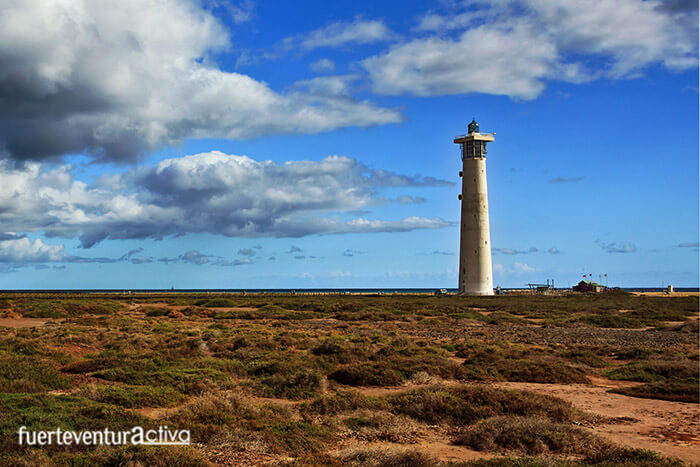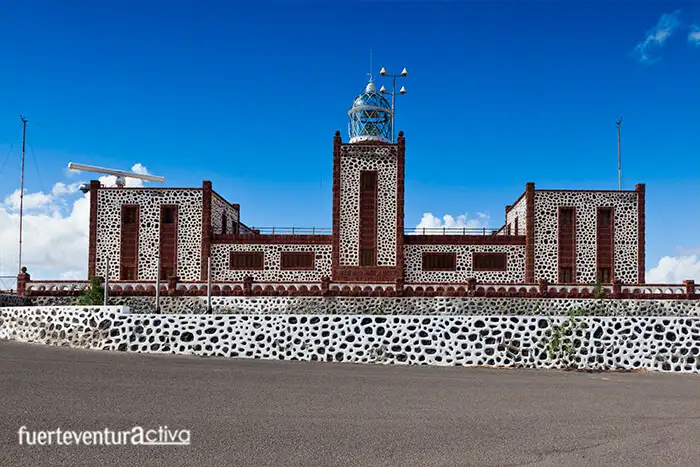Fuerteventura beaches, Routes and trails
Discover Fuerteventura through its lighthouses
The more we walk through Fuerteventura, the more in love we are with this island. Each place, each corner, is a new opportunity to discover something different. Today we propose you to explore Fuerteventura, from end to end, visiting its lighthouses, an experience that you cannot miss.
The lighthouses of Fuerteventura
Lonely, evocative, romantic … and of course, a source of literary inspiration. This is how the Majorero lighthouses are.
The lighthouses that we can currently see along the coast of Fuerteventura are relatively new. The oldest date from the 19th century. However, from the first moments of the Franco-Norman conquest, back in the 15th century, rough lighting structures were already erected that warned of the abrupt coast, in the darkness of the night.
Fuerteventura has 6 lighthouses and a beacon tower of some importance that, from south to north, watch over our coastline. They are the lighthouses of Punta Pesebre, Punta de Jandía, Morro Jable, Entallada, Punta Gavioto, Tostón, and Martiño. The latter on Lobos island.
Punta Pesebre beacon tower.

Beacons have a shorter range than lighthouses and are usually placed in channels, or in danger points close to navigable waters. Fuerteventura has several beacons that we can see at the entrances of the ports. They tend to be discreet and go unnoticed by the general public, as they are not usually associated with any building
However, the Punta Pesebre radio beacon is the exception. The small luminous point stands on a curious truncated pyramid-shaped construction, made of volcanic stone and concrete. In it gray and white are combined in a unique way.
The Punta Pesebre beacon is located in the extreme south-west of Fuerteventura, in a beautiful setting surrounded by steep cliffs that are worth discovering. The rocky cliffs, on both sides of the beacon, are interspersed with sandy coves, being the Ojos beach the most spectacular of all, very close to the next lighthouse: Punta de Jandía.

By the way, the origin of the toponym “Pesebre” is due to an error in the transcription of the speech of Fuerteventura. Actually we should call this point the Precebe (presebe) which is like majoreros, and canaries, formerly called barnacles. It was given this name because near this point there was a rock in the shape of said shellfish.
Googlemaps – Punta Pesebre beacon tower
Punta de Jandía lighthouse

The Punta de Jandía lighthouse was erected at the southernmost tip of the island, during the second half of the 19th century. The design was carried out by the young engineer Juan de León y Castillo. Its mission, at that time, was to guide the ships that from Europe headed to the ports of Spanish and French West Africa, as well as the ships that made the route from the port of Las Palmas to Gran Tarajal and Puerto Cabras (today Puerto del Rosario)
Its luminaire rises up to 33 meters above sea level, in a cylindrical tower. At its base is the keeper’s house, whose interior, currently closed, houses the Interpretation Center of the Jandía Natural Park and an exhibition on the seabed of the area and the cetaceans that inhabit them.
Outside the lighthouse, in the sea, we can see a curious fine line drawn by the waves in the opposite direction. This line is formed when the Barlovento and Sotavento currents collide.
Getting to this point is worth it, as is visiting the nearby beaches and Puertito de la Cruz.
Googlemaps – Punta de Jandía lighthouse
Morro Jable lighthouse

The Morro Jable lighthouse is one of the newest on the island. It is 60 meters high. It began to function in the 90s of the 20th century. It is located at the foot of the salt marsh and the Matorral beach, in the same town of Morro Jable, a place considered to be the origin of the island’s tourist awakening and the economic engine of the area.
Googlemaps – Morro Jable lighthouse
La Entallada Lighthouse

We continue our journey to the north of the island, and we arrive at the municipality of Tuineje. Just 6 kilometers from the town of Las Playitas stands imposingly on a rocky escarpment and at an altitude of 200 meters, the Entallada lighthouse, located in the area closest to the African coast.
Its construction dates from the middle of the 20th century. At the time it was advertised as the most powerful lighthouse in the Canary Islands. It was the last of the lighthouses built, in our country, with the classic concept of a tower with a house. Its striking “U” -shaped building houses a glass dome for optics, which is also a lighthouse for airplanes. Among the singularities of the property we can count that its corners have red ashlar masonry, extracted from the Bermeja mountain, in Tefía.
The Entallada lighthouse is one of the best enclaves to contemplate part of the Cuchillos de Vigán Natural Monument
Googlemaps – La Entallada Lighthouse
Punta Gavioto Lighthouse.

The Punta Gavioto lighthouse is located in Puerto del Rosario, just below the water treatment plant.
Among the peculiarities to highlight of this lighthouse is that in these lands there were some old salt flats: the Salinas del Viejo, which were active until the middle of the 20th century.
As with the Morro Jable lighthouse, the Punta Gavioto lighthouse dates from the 1990s. Its construction is austere and functional. It is based on a cylindrical tower of white color and 43 meters high.
Googlemaps – Punta Gavioto Lighthouse.
Tostón lighthouse

The Tostón lighthouse is located about 5 kilometers north of El Cotillo. This lighthouse, together with the Pechiguera lighthouse, in Lanzarote, and the Martiño lighthouse on the islet of Lobos, guide the boats that cross the Bocaina. It was built at the end of the 19th century. It currently has three towers of different heights and a large room that houses a forgotten Museum of Traditional Fishing.
Each of its towers was built at a different time, the lowest being the oldest, and the highest being the most modern.
This singularity (that of having 3 towers) responds to the demand of sailors for having a light to guide them on rainy nights. And it is that, the marine currents of the strait that separates Lanzarote and Fuerteventura, are very intense and have caused the stranding of various ships.
The tip of the Tostón is surrounded by reefs that form the anchorage of the same name under its shelter. This area was, centuries ago, one of the most important ports in Fuerteventura.
Googlemaps Tostón lighthouse
The Martiño lighthouse

The Martiño lighthouse is located at the northernmost point of the islet of Lobos. Its simple and functional architecture is the work of the engineer Juan de León y Castillo. It came into operation in the second half of the 19th century.
It took 5 years to finish, as several obstacles had to be overcome, including the construction of houses, laundries and corrals for the workers, the transfer of construction materials, food and water from Fuerteventura to Lobos, the opening of roads, etc.
Without a doubt, Lobos must have something special, since its lighthouse has been the cradle and shelter of great figures of Castilian literature. Josefina Plá, José Rial, Federico Doreste, even Alberto Vázquez Figueroa, whose grandfather was a lighthouse keeper in Lobos and spent part of his childhood here, are some examples of writers related to the Martiño lighthouse.
Googlemaps -The Martiño lighthouse
Fuerteventura1,Fuerteventura4





